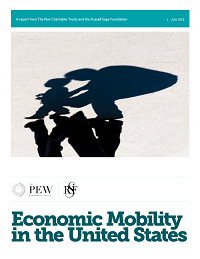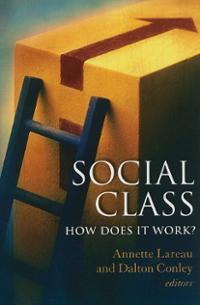The resurgent interest in inequality scholarship has opened up new possibilities for interdisciplinary communication and collaboration, but these possibilities have yet to be fully realized. The persistent effect of disciplinary boundaries, and of boundary policing, shows up in a variety of ways: interdisciplinary asymmetries in citations; the reinvention of the same ideas and research programs across multiple disciplines; the frequent misuse of terms or models by disciplinary interlopers; and, as we will argue here, discipline-specific operationalizations of inequality that needlessly narrow the scope of questions that we ask about inequality and social change.
“Most social scientists remain wedded to their own discipline’s preferred approach to characterizing the structure of inequality.”Even after a decade or more of institutional efforts to increase cross-disciplinary conversation, most social scientists remain wedded to their own discipline’s preferred approach to characterizing the structure of inequality. Economists, for example, default almost exclusively to measures of income, earnings, wealth, or poverty. Sociologists rely on measures of education, social class, or occupation. Health scholars use socioeconomic composites. Political scientists seem to be more catholic, but often rely on income or education.
These measurement approaches can be understood as implicit bets on the best way to summarize a complex, multidimensional space defined by a host of social and economic resources: (1) investments and endowments (e.g., formal schooling, vocational schooling, literacy, occupation-specific experience, firm-specific experience, total experience, cognitive skills, soft skills); (2) working conditions (e.g., type of employment contract, authority and autonomy, task complexity); and (3) social and economic rewards (e.g., wages and salaries, investment income, program income, wealth, property ownership, honor). Given the number of variables that define this space, it is hardly surprising that scholars simplify it to make analyses tractable.
“How do scholars decide on the right simplification?”How do scholars decide on the right simplification? Most frequently, they choose mainly out of disciplinary convention or tradition, often without empirical evidence to justify their choice. In some cases, scholars gesture to the importance of their discipline’s favored measurement approach, a gesture that sometimes rests on claims masquerading as facts. The standard-issue sociologist, for example, will often lead with the claim that social classes define interests, life chances, or life conditions, but rarely, if ever, will she offer evidence that establishes that the effects of class trump those of income, earnings, wealth, education, poverty, or socioeconomic status. In other cases, scholars simply justify their measures on the pragmatic grounds of data availability, with the tacit assumption that different dimensions of inequality are so tightly coupled that the choice of measurement doesn’t much matter.
This resort to stock claims is to be contrasted with the typically much fuller debates about how to implement a discipline’s preferred measurement paradigm. The disciplinary literatures are replete with arguments about which income concept (e.g., pre-tax, post-tax), class scheme (e.g., big-class, micro-class), poverty measure (e.g., relative, absolute), or socioeconomic composite (e.g., education, income) is preferable. These are important and healthy discussions, but they do nothing to justify the initial—and arguably more consequential—choice of a measurement paradigm itself.
As an example, consider intergenerational mobility research, which is carried out in parallel in economics and sociology. Economists typically examine earnings or income mobility, and ignore class or occupational mobility. Sociologists typically examine class or occupation mobility, and if they make any reference at all to income, it is to argue that income is derivative of class or occupational position. Cross-disciplinary forays in which economists examine occupation mobility1For example, see
Mazumder, B. and M. Acosta, “Using Occupation to Measure Intergenerational Mobility,” The Annals of the AAPS vol. 657 no. 1 (2015): 174-193.
More info → or sociologists examine income mobility2 For example, see
For example, see
Mitnik, Pablo A., Victoria Bryant, David B. Grusky and Michael Weber. (2015) Economic Mobility in the United States. Rep. Pew Charitable Trusts and the Russell Sage Foundation. Print.
More info → are still very much the exception.
Should this strong association between discipline and measurement approach trouble us? Not necessarily. If economists are asking questions about mobility that are best addressed with income or earnings measurements, while sociologists are asking questions that are best addressed with class or occupation measurements, the standard division of labor might be productive and defensible. To be sure, that division of labor cuts off the fresh insights that are often generated when a scholar approaches another discipline’s questions, but it is at least plausible that the cost of foregoing such insights is offset by the benefits of a sustained focus on a research question by scholars who are well-trained in the methods needed to take it on. Those benefits are, in effect, the returns to specialization. The simple conclusion here: if the disciplines are pursuing different questions, a disciplinary division of labor may advance social scientific knowledge more rapidly than through interdisciplinary inquiry.
But what if each discipline is asking the same underlying question? In the case of mobility research, it is revealing that the front-end of the typical sociologist’s or economist’s paper is often virtually identical, each referring to the need to assess the distribution of opportunities to get ahead. Although the underlying question is much the same, sociologists and economists approach it with very different measurement strategies.
In this context, disciplinary specialization has real costs, especially when it is coupled with imperfect communication and with balkanized research streams that do not take into account consistent or inconsistent results in other disciplines. It is even more troubling, in our view, that parallel streams of research prevent us from asking how different forms of mobility are interconnected. Are trends in income mobility driven by trends in occupation mobility (or vice versa)? Are the mechanisms that underlie income and occupational mobility the same, and if not, how do they differ? More recently, some efforts to examine multiple types of mobility simultaneously have emerged,3 For example, see
→ Breen, R., C. Mood, and J. Jonsson. (2016) “How Much Scope for a Mobility Paradox? The Relationship between Social land Income Mobility in Sweden,” Sociological Science, February 4, 2016. DOI 10.15195/v3.a3.
→ Grusky, David B., and Erin Cumberworth. (2011) “A National Protocol for Measuring Intergenerational Mobility?” National Academy of Science.
but they are still rare.
The mobility example illustrates the larger point that discipline-specific measures may lead us to overlook fundamental questions about what form inequality takes. The form of inequality is just as important, we suggest, as the amount of inequality in understanding the lived experience of inequality and how it is changing.
Where do we go from here?
The key task for inequality scholarship, in our view, is to convert discipline-specific preferences for particular measurements from purely metaphysical commitments into testable claims about the structure of the resource space and how it is changing.4 For methodological details, see
Grusky, David B., and Kim A. Weeden. 2008. “Are There Social Classes? An empirical Test of the Sociologist’s Favorite Concept.” in Social Class: How Does it Work?, eds. Dalton Conley and Annette Laureau. New York: Russell Sage Foundation. More info → In the balance of this essay, we provide a few examples of the assumptions that inequality scholars make when they adopt a particular measurement approach, and the types of questions that would open were they to instead test those assumptions and assess the form that inequality takes.
More info → In the balance of this essay, we provide a few examples of the assumptions that inequality scholars make when they adopt a particular measurement approach, and the types of questions that would open were they to instead test those assumptions and assess the form that inequality takes.
Does inequality take on a class form?
The rise of multidimensionalism within economics led to much fretting about the difficulty of parsimoniously characterizing the structure of inequality. The class models that sociologists often favor may provide a solution to this problem by characterizing the resource space in terms of a small number of classes comprising a distinct combination of endowments, working conditions, and rewards. The class of “craft workers,” for example, consists of individuals with moderate educational investments (i.e., secondary school credentials), considerable occupation-specific investments in human capital (i.e., vocational, on-the-job training), average income, relatively high job security, middling social honor and prestige, and quite limited authority and autonomy. The class of “professionals,” by contrast, consists of individuals with high educational investments, high skill, stable working conditions, comparatively high income, and considerable autonomy and social honor. Each of the other classes in conventional class models can also be understood as an institutionalized combination of resources. The class model thus reduces the dimensionality of the resource space to something tractable.
But is the class model on the mark? If we were to treat class models as testable hypotheses about the inequality space, we would open up new questions about class formation. Are the variables that make up the inequality space (e.g., education, working conditions, income) independent of one another within each class? Are social classes becoming more internally coherent, or less internally coherent? Has the takeoff in income inequality introduced more heterogeneity in all classes, or just some of them? Are classes better formed in some countries than in others? These types of questions are rarely asked, even though they speak directly to the viability of one of sociology’s signature ways of measuring inequality.
Do gradational models beat out class models?
The class model assumes that inequality is best measured at the “site of production.” It is possible that, contrary to that assumption, various distributional outcomes (e.g., wealth, income) are the more fundamental cleavages in contemporary forms of inequality. In the most extreme versions of this claim, class models rooted in the division of labor are treated as quaint artifacts of the mid-twentieth century, whereas wealth, income, or education hierarchies are assumed to capture the fundamental cleavages of contemporary inequality. These continuous variables sometimes are recast as categorical and given a class label: the “poverty” class, the “1 percent,” the top 10 percent, the rich. As best we can tell, such recastings are typically just shorthand summaries of an underlying continuous variable, rather than any serious hypothesis about truly discrete and institutionalized categories.
The gradational challenge to class models also implies a set of testable hypotheses about the form that inequality takes. If the underlying inequality variables covary within big classes or occupations, each individual becomes a class unto herself. This solution is consistent, for example, with the claim that income is a master variable, that it perfectly signals all other individual-level measures of inequality, and that higher-level class organization is absent. Although this ideal type would never be empirically realized in such extreme form, we presumably want to know whether the gradational form comes closer to being realized in some societies, time periods, or demographic groups than in others.
Is inequality becoming less organized?
In a non-class system (or, equivalently, a one-class system), the dimensions of inequality do not covary. Instead, inequality takes on a completely disorganized form where the independence assumption holds throughout the resource space, not just within a given class.
The extent of disorganization in the inequality space is important because it governs the amount of “total inequality.” If, for example, the takeoff in income inequality is coupled with rising disorganization, its effects will be moderated because privilege on one dimension of inequality domain no longer reliably implies privilege on another. This fragmented inequality regime may be more palatable and stable than an “all-or-nothing” regime in which those at the top are ever more advantaged on all dimensions of inequality, while those at the bottom are ever more disadvantaged on all dimensions.
“These crystallization and feedback loop hypotheses are testable and worth testing.”The layperson’s concern about rising income inequality is, we suspect, driven by the accurate perception that the biggest income gains are going to people in jobs and structural positions that are also advantaged in terms of their stability, working conditions, non-pay benefits, and other social rewards (e.g., prestige, autonomy). This lay perception of growing crystallization is sometimes tied to a feedback-loop hypothesis: The growing crystallization is assumed to increase the capacity of elites to secure legal and institutional changes that then “rig the system” ever more in their favor and enable ever more crystallization. These crystallization and feedback loop hypotheses are testable and worth testing.
Conclusions
We have not tried to identify all of the ideal-typical or hybrid forms that inequality may take. It would be straightforward to do so by extending our framework in various ways. It could be used, for example, to better understand the mechanisms through which inequality exerts its effect. It could be used to ask how the form of inequality differs across status groups (e.g., racial, gender, ethnic), family types, neighborhoods, or local labor markets. It could be used to ask how different forms of inequality are associated with political beliefs, lifestyles and consumption practices, or intergenerational mobility processes.
By way of illustration, consider again the case of intergenerational mobility research. Ironically, many economists have suggested that mobility should be measured multidimensionally (rather than via income alone) but haven’t sorted out how to do so, whereas many sociologists have long held a possible solution to multidimensionalism (i.e., the class model) but have not appreciated the problem that it may solve. If these two literatures were brought together, the income paradigm and the class paradigm become nothing more than testable hypotheses about the structure of the inequality space and about the type of mobility that is most prevalent within that space.
The larger point is that, rather than defaulting to disciplinary preferences, social scientists should explicitly examine their assumptions about how to simplify the multidimensional resource space into a tractable way of measuring inequality. Nothing in this agenda precludes important and productive differences between disciplines in approaches, models, or methods. It simply prods us to expand the domain of questions that we ask, and answer, about the form that inequality takes and how it is changing over time.
References:
Mazumder, B. and M. Acosta, “Using Occupation to Measure Intergenerational Mobility,” The Annals of the AAPS vol. 657 no. 1 (2015): 174-193.
More info →
 For example, see
For example, seeMitnik, Pablo A., Victoria Bryant, David B. Grusky and Michael Weber. (2015) Economic Mobility in the United States. Rep. Pew Charitable Trusts and the Russell Sage Foundation. Print.
More info →
→ Breen, R., C. Mood, and J. Jonsson. (2016) “How Much Scope for a Mobility Paradox? The Relationship between Social land Income Mobility in Sweden,” Sociological Science, February 4, 2016. DOI 10.15195/v3.a3.
→ Grusky, David B., and Erin Cumberworth. (2011) “A National Protocol for Measuring Intergenerational Mobility?” National Academy of Science.
Grusky, David B., and Kim A. Weeden. 2008. “Are There Social Classes? An empirical Test of the Sociologist’s Favorite Concept.” in Social Class: How Does it Work?, eds. Dalton Conley and Annette Laureau. New York: Russell Sage Foundation.
 More info →
More info →












